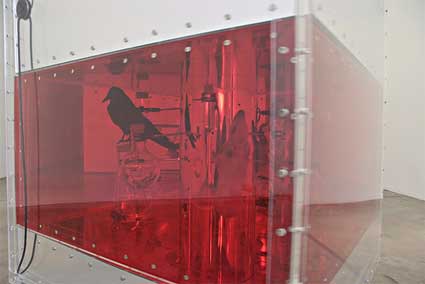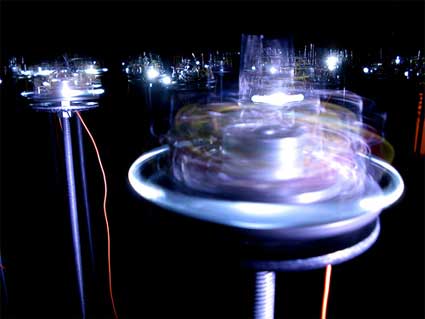The winners of the VIDA awards have been made public this morning in Barcelona.

The international competition on art & artificial life, a project set up 10 years ago by Fundación Telefónica, rewards works of art produced with and commenting on artificial life technologies.
The many projects which have received an award over the past ten years form an inestimable and unique collection documenting the evolution of electronic art in one of its most significant aspects. Previous winners include a robot that sweats, a walking table, robotic dogs suffering from the mad cow disease, solar-powered devices which modify their own instruction code in response to environmental changes, autonomous non-violent protest agents, a Universal Whistling Machine, etc.
The Head of Fundación Telefónica, Francisco Serrano, came with some good news at the press conference:
– next year they will double the amount of money granted to the artists,
– they will also create an award for a career,
– finally, FT will create a Virtual Gallery which will collect and exhibit the winning works of past and future editions.
The winning projects will be exhibited at the Fundación Telefónica stand in ARCO which takes place on February 13-18 in Madrid. Coinciding with the Madrid Contemporary Art Fair, a exhibition celebrating the tenth anniversary of VIDA will present a selection of the past award-winning works and an International Forum will gather experts from all over the world to discuss artificial life art.
 Mission Eternity Sparcophagus
Mission Eternity Sparcophagus
There was a presentation of the three winners this morning but a very brief mention of the honorary mentions. So i’ll just dive into the DVDs and paper documentation i got this morning and get back with more details on the honorary mentions later. In the meantime, here are a few words about the 3 winners.
First prize (10.000 euros) went to Mission Eternity Sarcophagus by etoy.CORPORATION (Switzerland), a mobile cemetery tank which allows for simple re-location of the “massive body of information” remains of up to 1000 M∞ PILOTS. The interior of the SARCOPHAGUS is covered with a LED screen which displays the ARCANUM CAPSULE content and functions as a public installation wherever the TANK travels. Visitors of the SARCOPHAGUS access and interact with ARCANUM CAPSULES via their mobile phones or a web browser. The VIDA jury liked the project for the way it expresses eternal human fears in an innovative way and for the fact that death and the technologically-mediated memory of a person are intricately linked to life itself, be it artificial or not.
 Oron Catts and Ionat Zurr, Noark
Oron Catts and Ionat Zurr, Noark
Second Prize (7.000 euros) went to NoArk (a work mentioned a few weeks ago), by Oron Catts and Ionat Zurr (Australia).
NoArk is an experimental vessel designed to maintain and grow “neo-life”, a mass of living cells and tissues that originated from different organisms. This vessel serves as a surrogate body for a collection of living fragments which are presented alongside technologically preserved specimens of organisms. The work questions the validity of taxonomical systems. These new organisms, instead of being part of a cabinet of curiosities like it would have been the case in the 19th century, are now collected inside hospitals, research centers, labs of the biotech industry, etc. Today we get to know life by tweaking it, not by just observing it. How can we define these new categories of life?
The artistic director of the Vida awards, Daniel Canogar, explained that the work met with much discussion inside the jury. For the first time VIDA didn’t give an award to a work based on electronics but on biotechnology. Yet it is still dealing with the concept of life, but in a broader sense.
 Propagaciones
Propagaciones
The third prize (3000 euros) went to Propagaciones, a work by Leandro Núñez (Argentina) which brings John Conway‘s cellular automaton The Game of Life (1970) to reality. The installation counts 50 small robots placed on top of a pole and made with low-tech elements. They have similar circuits and components but they all look different. They form a kind of ballet, interacting both with visitors and between themselves by turning on their lights or spinning around. Besides, the robots are divided in 10 nodes. Each robot interact with the other robots around but their behaviour inside a given node also depends on the one shown by the other nodes.
All images courtesy of Fundación Telefónica.
